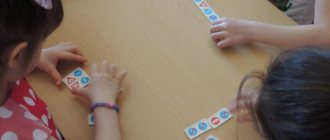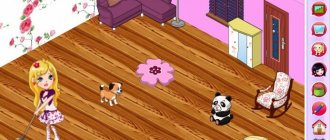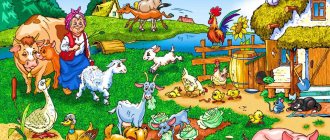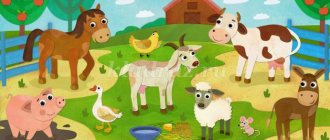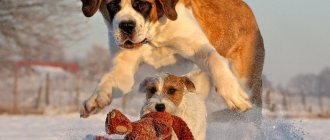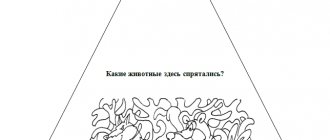Comprehensive thematic planning for the middle group. Lexical topic “Pets”
PLANNING EDUCATIONAL WORK FOR THE DAY
MONDAY 10/19/2021
GROUP
2 INTERMEDIATE 4
TOPIC:
“PETS AND BIRDS”
TARGET:
To develop the ability to recognize, name and distinguish the features of the appearance and lifestyle of animals, birds and their young, to cultivate a love for the animal world.
Develop a sustainable cognitive interest in pets and birds as living beings. Final event:
Creation of albums “Pets and Birds”.
Responsible for the final event:
group teachers. Date 10/23/2020
| Mode | Integration of educational regions | Joint activities of children taking into account the integration of educational areas | Organization of a developmental environment for children’s independent activities (activity centers, all group rooms) | Interaction parents, social partners | ||
| Group, subgroup | Individual | Educational activities in special moments | ||||
| 1 | 2 | 3 | 4 | 5 | 6 | 7 |
| Morning: breakfast, second breakfast: | Social-communicative, cognitive, speech, musical-aesthetic, physical development | Morning exercises. D/i “Guess who’s hiding”, “Wonderful bag” | Repeat and learn A. Barto’s poem “A Little Goat Lives with Me” Involve Karina A., Maxim K. | Situational conversation: “How domestic animals appeared” to give children accessible information about how people tamed animals. Eye gymnastics | Introducing visual material «Pets and birds » Entering game material, lotto “ pets and birds” » | Individual conversations: “Daily routine and its importance in a child’s life” Goal: Joint search for ways to solve educational problems. |
| Educational activities: | 9.00-9.20 Cognitive and research activities (FCCM) Topic “Pets” Goal: to introduce children to the names of pets, to the general concept of “pets”; explain what parts the body of animals consists of; what they eat, what benefits they bring. Formation of a holistic picture of the world. Middle group. O. N. Kaushkal, M. V. Karpeeva. Page 41. 10.00-10.20 Motor activity | |||||
| Walk: | Observations of bird tracks in the snow. P/I “Horses”, “Cat and Mice”. D/i “Traffic Signals” | PHYSICAL exercise “My funny ringing ball” Goal: to teach how to hit the ball with one hand. Involve Vanya N., Sasha A. | Work order: dig up the sand. Target: to teach children to help adults, to cultivate a desire to finish what they start. Sand games: “Treat for the cat” Goals: to teach children to use their knowledge. | Using external material, create conditions for independent play activities in the sandbox. Enrichment with farm game materials. Removal of labor equipment on site - rake | ||
| Dinner: | Conversation : “Why dry branches can be dangerous.” Goal: develop attention and personal safety. Formation of cultural and hygienic skills. | |||||
| Evening: afternoon tea | Invigorating gymnastics after sleep, walking on massage mats and “health paths” Introduce children to self-care (dressing, undressing, washing), promote the development of independence, volitional efforts, positive self-esteem. Game with the ball “Who is screaming like that?” - consolidate knowledge about home life. | Situational conversation “Who dresses how?” — consolidate the concept of “Seasonal clothing” Talk to Ruslan S., Arkhip Ch. | In the art studio: “Piglet” - Continue to teach children how to work with a variety of materials (natural or waste material, plasticine...) | Independent activity of children in activity centers. Role-playing game -Pet store"Continue to develop the ability to coordinate your actions with the actions of your partners, to observe role-playing interactions and relationships in the game. | ||
| Walk: | Children's games with external materials. Role-playing games of children's choice. Labor on site. Weather observations, compare morning and evening weather. P/I “Horses” “Cats and Mouse” |
PLANNING EDUCATIONAL WORK FOR THE DAY
TUESDAY 10/20/2020
GROUP
2 INTERMEDIATE 4
TOPIC:
“PETS AND BIRDS”
TARGET:
To develop the ability to recognize, name and distinguish the features of the appearance and lifestyle of animals, birds and their young, to cultivate a love for the animal world. Develop a stable cognitive interest in domestic animals and birds as living beings
| Mode | Integration of educational regions | Joint activities of children taking into account the integration of educational areas | Organization of a developmental environment for children’s independent activities (activity centers, all group rooms) | Interaction parents, social partners | ||
| Group, subgroup | Individual | Educational activities in special moments | ||||
| 1 | 2 | 3 | 4 | 5 | 6 | 7 |
| Morning: breakfast, second breakfast: | Social-communicative, cognitive, speech, musical-aesthetic, physical development | Morning exercises. Examination of toys - poultry (chicken, duck, rooster and their babies) - teach to visually distinguish, name, analyze bird toys, compare them with the image in the picture. | Looking at illustrations of pets. Goal: expand children's understanding of pets. Involve Lena A., Yaroslav I. | Situational conversation “What animals feel”; Introduce children to how animals react to changes in living conditions, human influence, find out the similarity of feelings between humans and animals (hunger, pain, pleasure, joy... Eye gymnastics | Work in the creativity center: Cutting out animals and birds according to a template - consolidate knowledge about domestic animals and birds, skills in working with scissors. Experimenting “Hide and Seek” – playing with water.” Independent games for children. | Encourage parents to talk with children about pets and birds |
| Educational activities: | 9.00-9.20 Musical and artistic (music) 9.30-9.50 Productive (drawing). Topic: Drawing “Barbos the Dog”: To consolidate children’s knowledge about color and geometric shapes (circle, triangle, oval). Continue to teach children to draw in an unconventional way: the method is to poke along the contour with a hard, semi-dry brush. Strengthen the ability to hold a brush; develop dialogical speech in children, activate vocabulary; to cultivate accuracy when working with paints, to evoke compassion and a desire to help the hero. Abstract Usatyuk O.N. | |||||
| Walk: | Cloud observations. P/I “Into the herd” “Shaggy dog.” D/i "Who's the odd one out" | PHYS exercise “Go around the obstacle” Purpose: To train children in walking and running between objects placed randomly throughout the playground. Involve Vanya S., Vova R., Maxim K. | Work order: remove trash from the area instill in children basic work skills and bring the job they start to completion. Study of leaf properties Look at it, smell it, test it for strength. Draw conclusions: the leaves have different shapes and colors, and are odorless. | Using external materials, create conditions for independent play activities in the sandbox. Enrichment of construction games with materials. Removal of equipment for labor in the area - rakes for collecting leaves. | ||
| Dinner: | ChHL M. K. Ushinsky “The Trickster Cat.” Goal: to develop the ability to listen, to monitor the development of action, to cultivate a caring attitude towards trees, to develop the ability to answer questions about the work. Formation of cultural and hygienic skills. | |||||
| Evening: afternoon tea | Invigorating gymnastics after sleep, walking on massage mats and “health paths” Introduce children to self-care (dressing, undressing, washing), promote the development of independence, volitional efforts, positive self-esteem. | In the Fine Arts Studio: “Turkey”, teach children to convey an image in a drawing, select the appropriate color scheme; develop a friendly attitude towards birds Polina F., Kirill P., Darina Z. | Etude “Caprizula” To help children develop an idea of the norms and rules of behavior and communication with each other. | Free activity in centers of creativity, books. Role-playing game “Veterinary Hospital” To introduce children to the game, to the profession of a veterinarian, to clarify their knowledge about home. animals, develop role behavior, train children in selecting attributes for the game. | ||
| Walk: | Observing the change in leaf color, how did they change, why? Goal: to develop observation skills, the ability to draw conclusions during observations.. P/game: . P/I “Horses”, “Cat and Mice”. Goal: development of general motor skills, coordination of movements. |
PLANNING EDUCATIONAL WORK FOR THE DAY
WEDNESDAY 10/21/2020
GROUP
2 INTERMEDIATE 4
TOPIC:
“PETS AND BIRDS”
TARGET:
To develop the ability to recognize, name and distinguish the features of the appearance and lifestyle of animals, birds and their young, to cultivate a love for the animal world. Develop a stable cognitive interest in domestic animals and birds as living beings
| Mode | Integration of educational regions | Joint activities of children taking into account the integration of educational areas | Organization of a developmental environment for children’s independent activities (activity centers, all group rooms) | Interaction parents, social partners | ||
| Group, subgroup | Individual | Educational activities in special moments | ||||
| 1 | 2 | 3 | 4 | 5 | 6 | 7 |
| Morning: breakfast, second breakfast: | Social-communicative, cognitive, speech, musical-aesthetic, physical development | Morning exercises.. Review of the album “Poultry” D\i “What kind of bird? Learn to recognize poultry by their characteristic features, describing them. | D/i “Kitten”; Continue work on familiarizing children with geometric shapes (circle, square), show techniques for planar construction from geometric shapes Involve Maxim K., Anton G. | Situational conversation What they eat at home. animals?" -consolidate children's knowledge about different houses. animals, what benefits they bring to humans. Eye gymnastics | Introduce the game “Connect the dots to make a puppy” into the center of mathematics and didactic games. Goal: Development of fine motor skills of the hand. | Distribute reminders to parents: “Works about domestic animals and birds” |
| Educational activities: | 9.00-9.20 Communication (speech development). Topic No. 5. Goal: acquaintance with the variety of words; dividing words into syllables; drawing needles on a Christmas tree. Workbook “From Word to Sound” E.V. Kolesnikova. Page 10. 9.30-9.50 Cognitive and research (design). Topic: master class “Pets” Goal: teach children to make three-dimensional crafts out of paper. https://www.maam.ru/detskijsad/detskii-master-klas-domashnie-pitomcy-po-konstruirovaniyu-iz-bumagi-v-srednei-grupe.html | |||||
| Walk: | Observations of passersby with dogs. Situational conversation “Rules of conduct with street dogs.” P/N “Geese, geese...” “Cat on the roof.” D/i “Draw an animal” | Exercise in PHYS “Sharp Shooter” Goal: to develop the ability to hit a target with a small ball. Involve Vera M., Vanya M. | Labor assignments - Collecting dry broken branches on the site. Raking dry leaves into a pile. Experimenting with air “Catch the air in a ball.” | Using external material, create conditions for independent play activities in the sandbox. | ||
| Dinner: | CHHL: Reading A. Vvedensky “About the girl Masha, about the dog Cockerel and about the cat Thread.” Goal: To teach children to perceive a large poem by ear, to instill in children a desire to protect our little brothers. Formation of cultural and hygienic skills. | |||||
| Evening: afternoon tea | Invigorating gymnastics after sleep, walking on massage mats and “health paths” Introduce children to self-care (dressing, undressing, washing), promote the development of independence, volitional efforts, positive self-esteem. | Introduction to the arts literature - compiling a plot story based on a set of toys “Tanya, Bug and Kitten” Learn to compose a story based on a set of toys; activity. children's speech. Involve Lena A., Ruslan S., Vanya S. | Role-playing game: “Train travel to the village” Purpose: Enriching the social experience of children (rules of behavior in the library, store, public transport, clinic, etc.). Development of dialogical speech skills. | Independent activity of children in activity centers. Collect the “Pets” mosaic. “Zoological Lotto”; D/game “Guess whose tail?” develop the ability to analyze; consolidate the ability to distinguish and name animals. | ||
| Walk: | Observing the change in leaf color, how did they change, why? Goal: to develop observation skills, the ability to draw conclusions during observations. Labor: collect sand around the sandbox. Cultivate hard work. Under. game “Free Space” Purpose: To develop dexterity and attention |
PLANNING EDUCATIONAL WORK FOR THE DAY
THURSDAY 22.10.2020
GROUP
2 INTERMEDIATE 4
TOPIC:
“PETS AND BIRDS”
TARGET:
To develop the ability to recognize, name and distinguish the features of the appearance and lifestyle of animals, birds and their young, to cultivate a love for the animal world. Develop a stable cognitive interest in domestic animals and birds as living beings
| Mode | Integration of educational regions | Joint activities of children taking into account the integration of educational areas | Organization of a developmental environment for children’s independent activities (activity centers, all group rooms) | Interaction parents, social partners | ||
| Group, subgroup | Individual | Educational activities in special moments | ||||
| 1 | 2 | 3 | 4 | 5 | 6 | 7 |
| Morning: breakfast, second breakfast: | Social-communicative, cognitive, speech, musical-aesthetic, physical development | Morning exercises. Compiling a descriptive story based on the picture “My favorite pet” according to the proposed plan. clarification of vocabulary on the topic. | Repeat D/I “Where, whose mother?” develop the ability to find the baby’s mother and learn to name the baby’s mother; development of attention and memory. Involve Vanya S., Kirill B. | Situational conversation “Cats and dogs are our neighbors”, teach to understand the condition and behavior of animals; know how to communicate with them; develop a caring and caring attitude towards animals. Eye gymnastics | Introduction Board-printed games – “Whose Tail”, “Whose Paw” Goal: Development of fine motor skills - offer to find and cut out pictures of animals and birds, stick them in an album or make a collage | Conversations with parents about the well-being of children. |
| Educational activities: | 9.00-9.20 Productive (application) D.N. Koldina, page 27 Topic: “Dog Kennel” P.S: Learn to cut a square into two triangles, and a circle into two semicircles. Continue to learn how to compose and carefully paste an image of an object from several parts. Teach to understand the content of the story, cultivate responsiveness and kindness. Learn to work in pairs. 10.20-10.40 Dvigatelnaya (street) | |||||
| Walk: | Cat observations. Situational conversation - “How a cat cleans its fur with its tongue” “Why you can’t pet street animals.” Teach careful handling of animals. P/I "Cat and Mice" "Shaggy Dog" D/i “Find mistakes | Practice walking like a snake between objects without knocking them over. Involve Anton G., Yulia N. Vanya N. | Labor assignments - Collecting dry broken branches on the site. Raking dry leaves into a pile. Experimenting with air and leaves. | Using external material, create conditions for independent play activities in the sandbox. | ||
| Dinner: | CHHL: Reading. Suteev. “Who Said Meow” Purpose: To teach children to perceive a large poem by ear, To instill in children a desire to protect our little brothers. Formation of cultural and hygienic skills. | |||||
| Evening: afternoon tea | Invigorating gymnastics after sleep, walking on massage mats and “health paths” Introduce children to self-care (dressing, undressing, washing), promote the development of independence, volitional efforts, positive self-esteem. | Theatrical games - Theatricalization of the fairy tale “The Wolf and the Seven Little Goats” - to expand a stable interest in theatrical activities, the ability to communicate emotionally and expressively. Involve Darina Z., Vanya N., Vanya S. | Learning to sit correctly at the table: developing cultural and hygienic skills. | Independent play activity Game - quiz on the topic: “What fairy tale are these animals from?” - reinforce with children the names of fairy tales in which animals participate. | ||
| Walk: | Watching the sunset. Purpose: to note the decrease in daylight hours. Children's games with external materials. Role-playing games of children's choice. Labor on site. Weather observations, compare morning and evening weather. P/I "Wolf and Sheep", "Funny Animals" |
PLANNING EDUCATIONAL WORK FOR THE DAY
FRIDAY 23.10. 2021
GROUP
2 INTERMEDIATE 4
TOPIC:
“PETS AND BIRDS”
TARGET:
| Mode | Integration of educational regions | Joint activities of children taking into account the integration of educational areas | Organization of a developmental environment for children’s independent activities (activity centers, all group rooms) | Interaction parents, social partners | ||
| Group, subgroup | Individual | Educational activities in special moments | ||||
| 1 | 2 | 3 | 4 | 5 | 6 | 7 |
| Morning: breakfast, second breakfast: | Social-communicative, cognitive, speech, musical-aesthetic, physical development | Morning exercises. Looking at family albums. Finger gymnastics “Cat” Game "Guess who". | "Orientation on a sheet of paper" Goal: to consolidate the ability to navigate on a sheet of paper: right, left, top, bottom, center. Involve Maxim K., Yaroslav I. Polina F. | Situational conversation “Do you know how to handle animals?” give knowledge about the rules of behavior when meeting various pets and when communicating with them. Eye gymnastics | Free activity for children in activity centers. Enrichment with materials from the s/r game - “Veterinary hospital” | Individual conversations with parents on topics that concern them. Goal: dissemination of pedagogical knowledge among parents |
| Educational activities: | 9.00-9.20 Motor activity. Under the guidance of a physical education instructor. 9.30-9.50 Musical and artistic (music) | |||||
| Walk: | Bird watching. P/I “Horses” “Cats and Mouse” D/i “I know five names of birds” | Practice landing on bent legs when jumping from hoop to hoop. Involve Varya Z., Vova R., Arkhip Ch. | Situational conversation “What does the proverb mean: Look for a friend, and if you find him, take care”? - to form the moral education of children. | Independent activity of children during a walk, games of their choice. Pay attention to the relationships between children and ways out of conflict situations. | ||
| Dinner: | CHHL: Reading E. Charushin “Why was Tyupa nicknamed Tyupa” Purpose: To teach children to correctly understand the moral meaning of the work, to evaluate the actions of the hero of the story. Goal: To teach children to perceive a large poem by ear, to instill in children a desire to protect our little brothers. Formation of cultural and hygienic skills. | |||||
| Evening: afternoon tea | Invigorating gymnastics after sleep, walking on massage mats and “health paths” Introduce children to self-care (dressing, undressing, washing), promote the development of independence, volitional efforts, positive self-esteem. | Construction of “Build a house for a dog” from small building material. | Household work – washing painting trays. | Land of animated dreams; Teach children to come up with the names of unusual animals (pig cat, rabbit, cat...) and depict them. Screening of the cartoon “Who Grazes in the Meadow” Creation of albums “Pets and Birds” | ||
| Walk: | Cat observations. Consider it, ask the children what benefits a cat brings to people as a pet. — consolidate the concept of “pet”. Independent games for children. P/I “Horses”, “Cat and Mice”. |
